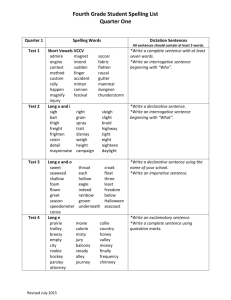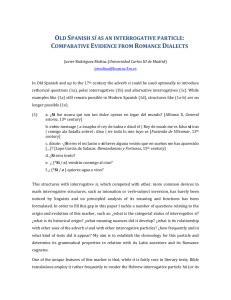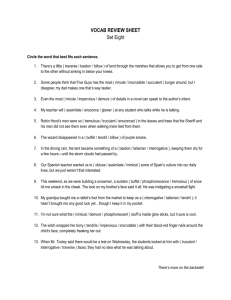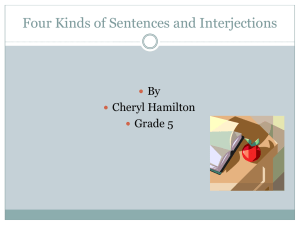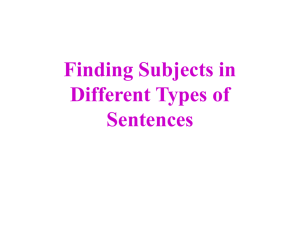Dewaele, Jean-Marc (1999) Word order variation in interrogative
advertisement
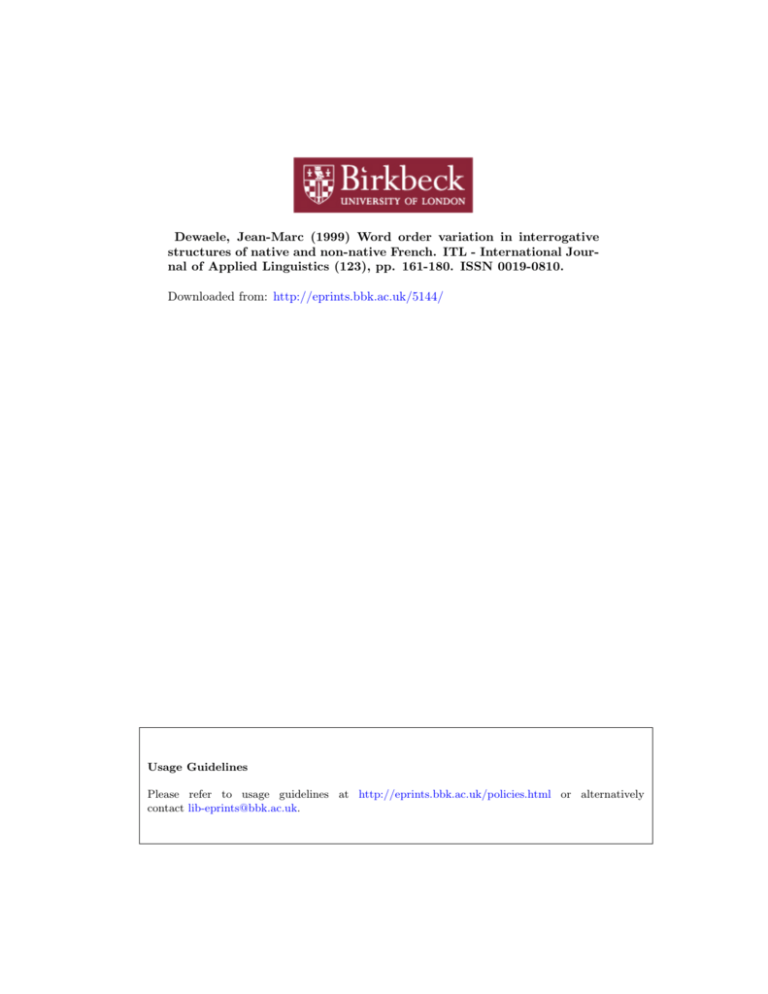
Dewaele, Jean-Marc (1999) Word order variation in interrogative structures of native and non-native French. ITL - International Journal of Applied Linguistics (123), pp. 161-180. ISSN 0019-0810. Downloaded from: http://eprints.bbk.ac.uk/5144/ Usage Guidelines Please refer to usage guidelines at http://eprints.bbk.ac.uk/policies.html or alternatively contact lib-eprints@bbk.ac.uk. BIROn - Birkbeck Institutional Research Online Enabling open access to Birkbeck’s published research output Word order variation in interrogative structures of native and non-native French Journal Article http://eprints.bbk.ac.uk/5144 Version: Accepted (Refereed) Citation: Dewaele, J.-M. (1999) Word order variation in interrogative structures of native and nonnative French ITL - International Journal of Applied Linguistics 123, pp.161-180 © 1999 Peeters Online Journals Publisher Version ______________________________________________________________ All articles available through Birkbeck ePrints are protected by intellectual property law, including copyright law. Any use made of the contents should comply with the relevant law. ______________________________________________________________ Deposit Guide Contact: lib-eprints@bbk.ac.uk WORD ORDER VARIATION IN FRENCH INTERROGATIVE STRUCTURES Preprint version. ITL Review of Applied Linguistics, 123/124, pp. 161-180 (1999). Dr. Jean-Marc Dewaele French Department Birkbeck College, University of London 43 Gordon Square London WC1H 0PD U.K. tel./fax (private) +44 181 368 00 86 e-mail: j.dewaele@french.bbk.ac.uk 1 WORD ORDER VARIATION IN FRENCH INTERROGATIVE STRUCTURES* ABSTRACT Inter-individual variation in the use of direct interrogative structures (N=450) is explored in a corpus of spoken native and non-native French. A quantitative analysis of the data reveals that while non-native speakers seem to avoid non-standard structures, they do not use more formal variants systematically. Comparison with data from other native and non-native corpora reveals important differences in the frequency of particular interrogative structures. The choice of interrogative structure seems to be influenced by a number of situational, pragmatic and socio-stylistic variables. 1. INTRODUCTION French has a wide range of interrogative structures that have very specific sociostylistic values. Certain structures are considered formal and are consequently used in written language or in speech produced in formal situations. However there is, as we shall see, considerable variation among native speakers in the choice of particular structures. The variation could be expected to be even higher in non-native speech as learners struggle to master the sociolinguistic norms of the target language (cf. Regan, 1997). The aim of the present article is to analyse 450 direct interrogative structures in the spontaneous oral discourse of 5 native speakers (hence NS) and 15 non-native speakers (hence NNS) of French and to identify the main sources of variation in the data. 2 The following research questions will be addressed: * Do advanced speakers of French interlanguage differ from NS in their use of interrogative structures ? * If there is a difference, do NNS of French prefer the more formal interrogative structures ? In an earlier study (Dewaele, 1992) on the variable omission of the negative particle in the advanced French interlanguage of Flemish students, we found that the 21 subjects omitted the negative particle “ne” much less frequently than NS do. We concluded that language learners who are still acquiring sociolinguistic competence and the vernacular style of the target language tend to use more formal structures when they have the choice between socio-stylistic variants. This finding was confirmed by Regan (1995, 1997) who found that her 6 advanced Irish learners of French L2 deleted the “ne” twice as often after they had spent an academic year in France. One might therefore expect a higher frequency of interrogative structures considered as being more formal in the native speaker community, such as those with clitic inversion, and a lower number of structures considered non-standard in the interlanguage of the learners. 2. DEFINITION OF THE VARIABLES We will not consider indirect interrogatives of which there were only 3 occurrences in the corpus. Eighteen declarative clauses with interrogative tag (n’est-ce pas) and 154 interrogative structures without verb, for example bare WH-words (pourquoi pas ?) are also excluded from the present analysis. 3 The remaining 450 direct interrogative structures can be divided in two broad categories, Yes/No interrogatives (YNQ) and WH interrogatives (WHQ). Coveney (1996) argues that this division, which reflects that used by Pohl (1965), Price (1971) and Al (1975), “is motivated both linguistically and sociolinguistically: linguistically, because the two types of questions have distinct syntactic, semantic, and pragmatic properties; and sociolinguistically, because (YNQ) has three variants, whereas (WHQ) have five or more, and these variants have distinct sociolinguistic values attached to them” (Coveney, 1996: 92). The structures to be examined here are set out in 1-8, together with an example of each: (1) 1) [SV] *MAR: vous n’avez pas de difficulté avec l’anglais ? 2) [ESV] *DJE: mais est-ce qu’il y a des cours que vous préférez ? 3) [V-CL] *STE: pouvez-vous donner une description ? 4) [QSV] *XEN: donc pourquoi tu as choisi d’euh d’étudier à Birkbeck ? 5) [QESV] *CHR: qu’est-ce que tu vas aller faire à un cours pareil ? 6) [SVQ] *TAN: tu habites où à Londres ? 7) [QV-CL] *KAR: ben pourquoi as-tu continué tes études ? 8) [QV-NP] *ALI: quelle est votre motiv0 # motivisat0 # motivation ? (key: S = subject clitic or Noun Phrase; CL = subject clitic; NP = subject Noun Phrase; V = verb; E = est-ce que/qui; Q = WH word or phrase) 4 2.1 The prescriptive norms Grammarians of French such as Wagner & Pinchon (1962) and Grevisse (1980) present socio-stylistic classifications of interrogative structures. The structures [VCL], [QV-CL] and [QV-NP] are generally considered to belong to the careful style, the structures [ESV] and [QESV] are considered neutral but rather inappropriate in writing, the structures [SV] and [SVQ] are considered colloquial but correct in speech (2), the structure [QSV] is generally labelled “working-class” and incorrect. Coveney (1996) observes that “the stigma attached by grammarians to certain variants has, via the education system in particular, very probably played a major part in restricting the use of non-standard structures” (1996: 98). Wagner & Pinchon (1962: 539) link the choice of a particular variant to the background of the speaker (“le degré de culture de la personne qui parle”), to the situation, the kind of register used and stylistic requirements (“rythme, harmonie”). Native speakers of French are conscious of the socio-stylistic value of variants. Lightbown (1979: 121), for example, found that Canadian adult native speakers of French speaking to child learners of French used significantly more structures with inversion ([V-CL], [QV-CL]) when the situation became more formal. One should not think, however, that the socio-stylistic classification of interrogative structures is cast in stone. Huot (1997) pointed out that not all interrogative structures with clitic inversion necessarily belong to a formal style. She illustrated her point with the example: Pourquoi veux-tu qu’on parte ? which she calls a “tour contestataire” that belongs to the familiar style despite the inversion. 5 2.2 The descriptive norms Table 1 presents quantitative data on types of interrogative structures in two corpora of spoken native French (Gadet, 1989 and Coveney, 1996). We selected these two corpora because it is recent material and typical of the sort of input to which our own subjects are exposed to. Gadet’s corpus is based on 90 minutes of ordinary conversations between native speakers over the telephone (Gadet, 1989: 142) (3). Coveney’s corpus of 250,000 words is based on 18 hours of informal interviews between himself (a non-native speaker of French) and 30 native speakers of French in a holiday camp in Picardy. There are 16 males and 14 females, aged between 17 and 60, ranging from working class to upper class. The principal topic is the informant’s experience of holiday camps (1996: 15-16). Coveney analysed the (relatively few) questions whih the informants asked the fieldworker. INSERT TABLE 1 As with previous research (4), the number of YNQ tokens is consistently higher than that of WHQ tokens. Gadet (1989: 144) observes that this difference in her data cannot be attributed to chance. Coveney (1996) underlines the fact that YNQ are used for a wider range of communicative functions than are WH interrogatives, hence the smaller number of the latter (1996: 118). Brown & Yule (1983: 79-83) are of the opinion that this preponderance may be due in part to the fact that the Yes/No interrogatives make less presuppositions than WH interrogatives, and are therefore more likely to be used in situations where the pool of presuppositions shared by the 6 speaker and the addressee is more limited. Gadet’s data are based on telephone conversations which have been proved to be less implicit than the face-to-face conversations from Coveney’s corpus where speakers share the same spatio-temporal context (cf. Dewaele, 1996). Sadock & Zwicky (1985: 178-84) suggest that Yes/No interrogatives are more frequent because they are the more basic syntactic structure. Whereas Yes/No interrogatives seem to be present in all languages, some languages do without WH interrogatives. The balance between YNQ and WHQ also seems to be determined by the language functions of the interrogatives. Lyster (1996) analysed 286 interrogatives produced by 44 adolescent native speakers of French in the Quebec city area. The subjects produced requests, complaints and offers in interrogative form addressed to peers and adults. Lyster counted 270 YNQ tokens and only 16 WHQ tokens. The data presented in table 1 illustrate the fact that there is no single descriptive norm of interrogative structures in modern spoken French. A Chi Square analysis revealed that the proportions of YNQ variants are significantly different between Gadet and Coveney (Df = 2, Chi2 = 12.1, p < .002), and that the proportions of the WHQ variants are equally dissimilar (Df = 4, Chi2 = 6487.9, p < .0001). Coveney (1996) presents relative frequencies for YNQ and WHQ in 10 corpora of native French gathered by different researchers over the years (Coveney, 1996: 11112). The variation appears to be even more important. The proportion of [V-CL] structures in the Yes/No interrogatives, for example, varies between 0.5% and 20%, whereas among the WH interrogatives, the [QESV] structure varies between 6% and 6%, the [QV-CL] structure between 3% and 50% and the [QV-NP] structure between 0.5% and 12%. 7 The same variation seems to exist in different corpora of non-Continental French such as the French spoken in Quebec. Lyster’s (1996) study (5) revealed “minimal use of uninverted questions with rising intonation and considerable use of inversion in spoken French” (Lyster, 1996: 175). Inverted questions and questions with interrogative suffix “-ti” (Je peux-ti t’aider?) accounted for 58.4% of the questions produced (6). Lyster’s findings stand in contrast to those of Lightbown (1980) and Lightbown & d’Anglejean (1985) (7). The authors report that the speech addressed by one adult native speaker to child learners of French L2 in Quebec contained almost no inverted forms -”even in information-eliciting questions” (Lightbown & d’Anglejean, 1985: 418). A similar absence of inversion was noted in a corpus of 400 questions addressed by one native speaker of French in Montreal to 2 adult French L2 learners (Lightbown & d’Anglejean, 1985: 418). Lightbown (1980) presents the results of a study on the emergence of question forms in L2 French of 2 boys who were native speakers of English. The boys used inversion only in a few rote-learned questions: “There are no examples of full-verb inversion with Q-words (...) and inversion was rare in Yes/no questions as well” (Lightbown, 1980: 168). The adult interlocutors who interacted with these learners also rarely used inversion for forming questions. 2.2.1 Variation within Coveney’s corpus Coveney (1996) identified a number of factors responsible for the variation he found in his corpus. Few of these, however, could account for the variation in our corpus (see infra). The main reason for this is that the questions he identified in his corpus of 250,000 words have a wide range of communicative functions (1996: 123). Our corpus is 10 times smaller and has a much higher proportion of questions with the 8 same propositional content (namely requests for information and for opinions) and of sub-topic-introducing questions (see next section). Coveney thus writes “that a significant proportion of the tokens of the YNQ variable were found to be constrained by various pragmatic factors: i.e. speakers had no choice of structure, given the communicative function” (1996: 247). Contrary to what our findings, he observed, for example, that the [ESV] structure “was used only rarely when the speaker expected an answer from the addressee” (1996: 247). The tokens with clitic inversion were so limited that he could not analyse the variation, and the [QV NP] structure appeared to be “constrained principally by linguistic factors” (1996: 247). The choice between [SVQ] and WH-fronted variant “proved to be conditioned by a strong discoursal constraint: the less informative the subject and the verb, the higher the probability of [SVQ] being selected” (1996: 247). Variation linked to social differentiation was modest and “sex appeared to be the most important extralinguistic variable affecting WHQ, with male informants showing a stronger tendency than females to use the non-standard [QSV] structure” (1996: 248). The absence of a single descriptive norm in the frequency of usage of different interrogative structures in native French makes a comparison with non-native French more difficult. Numerous factors, moreover, appear to be linked to the choice of a particular structure. However, as our data contain material produced by both NS and NNS in similar situations and covering similar topics, we consider that variation can in fact be accounted for and that answers can be found to the research questions which we have asked. 9 3. METHODOLOGY Nine female and 11 male speakers, aged between 20 and 60, participated in the experiment. They are full-time students in the French Department of Birkbeck College, University of London. 5 subjects are NS of French, but have been working in London for at least 2 years; 15 subjects are native speakers of English. All subjects use English most frequently. Lightbown & d’Anglejean noted that “it is difficult to elicit a substantial corpus of spontaneous questions from second language learners” (Lightbown & d’Anglejean, 1985: 423). To avoid this difficulty our subjects were asked to choose a partner to interview and be interviewed by (8). By dividing the subjects into dyads we were confident that a sufficient number of interrogatives would be produced. 6 NNS-NNS dyads were formed, 2 NS-NS dyads and 3 NNS/NS dyads during 2 one-hour sessions. 5 dyads were same sex, 7 dyads were mixed. The researcher handed over a list with topics for discussion and explained that everybody was free to determine the number of questions, and that the interview should last about 15 minutes, after which the interviewee would become the interviewer. The subjects talked about their studies, hobbies, work, family, hopes and fears. Personal topics of this sort contribute to an informal atmosphere in which authentic speech can be produced (cf. Reboullet, 1979; Trévise & Noyau, 1984). Each pair of subjects audio taped their interviews and transcribed them afterwards following the CLAN format (cf. McWhinney, 1995). The transcriptions were then checked by the researcher who also participated in the interviews to make up the numbers. The resulting material (25,068 words) is of a quasi-spontaneous nature, resulting from peer-group interaction. This is generally considered (cf. Milroy, 1987) the best linguistic data. Interrogative structures were then singled out manually. 10 All subjects filled out a questionnaire relating to all typical sociobiographical data such as sex, age, profession and details concerning their linguistic history: first, second, third, fourth or fifth language, amount of time spent in France, number of years attending French courses, frequency of speaking, reading, hearing French, and most frequently used language in their everyday life. The material of three subjects who were interviewees but not interviewers was excluded on the basis that the few interrogative structures they produced were categorical tokens on account of pragmatic factors or lacked a verb as illustrated in (10): 10) *NEI: (interviewer) tu vas prendre des vacances en Angleterre par exemple ? *AIC: (interviewee) prendre des vacances ? In cases of immediate and identical repetition of the interrogative, only the first occurence was counted, as in example (11): 11) *DEV: (interviewer) est-ce que tu fais+... *PAT: (interviewee) euh +... *DEV: est-ce que tu fais un travail à # à temps partiel ? 4. ANALYSIS Table 2 presents the quantitative data on the types of interrogative structures in our corpus of 5 NS and 15 NNS. INSERT TABLE 2 11 4.1 Comparison with the corpora of Gadet (1989) and Coveney (1996) The differences between the proportions of YNQ and WHQ tokens for our speakers (NS and NNS) (table 2) and the results of Gadet (1989) and Coveney (1996) (table 1) are all highly significant (p < 0.001). The most interesting difference, however, is that whereas Coveney’s subjects produced no clitic inversions in the Yes/No interrogatives, for the WH interrogatives they produced many more [QESV] and many fewer [QV-CL] and [QV-NP] variants. The [QV-CL] structures account for 20.6% of the tokens in our corpus whereas this structure accounts for only 6.6% of the WHQ tokens in Coveney’s corpus and 12% in Gadet’s corpus. The [QV-NP] structure is also 10 times more frequent in our corpus (25.4%) than in Coveney’s corpus. The [QV-NP] structure is absent from Gadet’s data. Different explanations are possible for this phenomenon. Coveney (1996) interviewed his informants in a holiday camp in a very informal atmosphere (9). It might thus be that the situation was considered less formal by the speakers and that they did not feel that the use of formal variants of interrogatives was required. Gadet (1989) gives less background information about the situation in which her telephone conversations were recorded, but the examples presented suggest that the interlocutors knew each other and used vernacular, informal speech. Our subjects operated inside the university building during class hours. This might have led them to believe that a more formal style, and thus interrogative structures with inversion, were appropriate. We analysed whether there was a correlation in our data between the number of inversions and the frequency of the “vous” pronoun, which is another indicator of formality. No significant correlation was found for the 12 corpus as a whole. An analysis of variance (hence ANOVA) revealed, however, that NNS used more vouvoiement (Mean = 56.7%, SD = 42.9) than the NS (M = 11.7%, SD = 10.9). This difference was significant (F = 5.17, p < 0.036). This divergence was reflected in the number of interrogative structures with clitic inversion of the NNS which used “vous” twice as frequently (24 “vous” versus 12 “tu”). The opposite pattern emerged for the NS, the number of inversions with “tu” being more than twice as frequent as those with “vous” (12 versus 5). 4.2 Sources of variation in our corpus 4.2.1 Inter-individual variation Let us now look at inter-individual variation in our data. The proportions of the 3 Yes/No interrogatives and of the 5 WH interrogatives were calculated for every speaker in our corpus. Although the variable NS versus NNS was hypothesised to be the main source of variation, we checked to see whether other sociobiographical variables affected the choice of interrogative structures. An ANOVA allowed us to single out factors responsible for variation. Social background, age, sex, frequency of speaking, reading or hearing French, type of motivation for learning French and, more surprisingly, native or non-native status did not appear to be significantly related to preferences for particular interrogative structures. The lack of significant differences between NS and NNS could be due to the relative imbalance between the number of NS (n = 5) and NNS (n = 15). To avoid distortion due to the small number of NS, the absolute and relative frequencies of interrogative structures of the two groups were 13 then considered as a whole and compared to Gadet’s and Coveney’s data on native speakers (cf. table 1). A Chi-Square analysis was performed on the relative values of interrogative structures of both groups. The differences in the proportion of the 3 Yes/No interrogatives are non-significant between our group of NS and NNS (Df = 4; Chi2 = 0.278; ns). The two most striking differences between the NS and NNS in the WH interrogatives are the relatively higher proportion of QSV among the NS (+14.7%) and the relatively higher proportion of [QV-NP] in the speech of the NNS (+11.4%). A Chi Square analysis reveals that the differences between NS and NNS are highly significant for the WH interrogatives (Df = 4; Chi2 = 32.1; p <.001). It is surprising that the NS speakers use more formal interrogatives with inversion [QV-CL] in the WH interrogatives, but that this preference does not extend to the formal interrogatives with inversion in the Yes/No interrogatives [V-CL]. 4.2.2 Verb types and tenses Following Lyster’s finding that the verb “vouloir” particularly favoured inversion in his data (Lyster, 1996 and personal communication), we analysed the type of verbs that were used in interrogative structures with inversion ([V-CL] [QV-CL]). The NNS used 14 verb types, the most frequent one being the auxiliary verb “avoir” with 13 occurrences. The NS used 6 verb types among which “avoir” also had the highest frequency with 10 occurrences. Other verb types used by the NS and NNS in inversions included “pouvoir” (n = 7), “trouver” (n = 6), “faire” (n = 4), “vouloir” (n = 3). We also checked to see whether tense affects the choice of interrogative structures. The majority of the interrogative structures with clitic inversion are in the present tense (84.2 %). This is not markedly different from the corpus as a whole: 14 352 interrogatives out of 450 are in the present tense (= 78.2%), 72 in the past tense (= 16%) and 26 in the conditional or future tense (= 5.7%). It thus seems that tense is not a source of variation in our corpus. 4.2.3 Pragmatic factor We saw earlier that an ANOVA could not single out any socio-biographical variable having a significant effect on the variation in our data. One pragmatic factor, however, was found to be linked to the choice of interrogatives structures with inversion. The 13 speakers (3 NS and 10 NNS) who used [V-CL] and [QV-CL] structures chose these in more than 95% of the cases to introduce a new topic or a new theme within a topic, as illustrated in example (12): 12) *TER: je pense je crois qu'il faut vraiment euh connaître une langue très bien. *MAR: oui. *TER: euh assez pour enseigner ça c'est le cas bien sûr. *MAR: et voudriez-vous euh enseigner dans un collège pour les adultes # comme Birkbeck ? The effect of this pragmatic factor on the choice of interrogatives with clitic inversion seems to exist in Gadet’s (1989) NS corpus too, although she does not mention it. The two tokens (examples 13 and 14) of the [V-CL] structure in her corpus (Gadet, 1989: 144) clearly indicate the introduction of a new topic: 13) ce week-end / va-t-on voir des trucs ? 14) Marie-Laure est-elle là ? 15 Gadet observes similarly that the 5 tokens of the [QV-CL] structure in her corpus occur at the beginning of the exchange and that the Q-word is the adverb “comment” in all 5 cases (1989: 145). In her study on questions produced by one native speaker in the Interfra corpus (cf. Bartning, 1997) and a corpus of 39 Swedish NNS of French, Larsson Ringqvist (1997) found that 66% of the clitic inversions in the speech of the native speaker signalled a change of topic or an expansion inside a topic (10). Larsson Ringqvist did not find the same patterns in her corpus of 39 NNS. 4.2.4 Possible crosslinguistic influence Crosslinguistic influence (11) from English might explain the lower proportion of [QSV] interrogatives in the speech of the NNS. This [QSV] structure is unacceptable to speakers of standard English. The [SV] structure in YNQ on the other hand is possible in English (cf. Lightbown & d’Anglejean, 1985: 422), although subjectauxiliary inversion is generally assumed to be obligatory. The absence of the [QSV] structure in the speaker’s English combined with the condemnation of the [QSV] structure in French grammars might explain why NNS of French tend to avoid this specific interrogative structure. Instead they prefer the more familiar and more formal [QV-CL] interrogative in WH interrogatives. All NNS declared in the sociobiographical questionnaire that English was the language they used most frequently in everyday life, although 7 NNS do not have English as a L1. We therefore assume that English has a higher level of activation in the mind of our NNS (cf. Green, 1986). This means that English plays a role in the ongoing processing, works in parallel to the selected language (French) but has no direct access to the out-going speech channel. We demonstrated in a recent study on 16 lexical inventions in the French interlanguage of 39 Flemish learners (Dewaele, 1998) that the level of activation of background languages determines possible transfer of morphological and lexical information to lemmata in the selected language. The effects of activated background languages can be very subtle. It is possible that a speaker, having the choice between different structures in the selected language, will select one that is similar to the structure most frequently used in one of his/her activated languages. The systematic inversion in English interrogatives might therefore have raised the probability of the choice of an [QV-CL] interrogative when speaking French. 5. CONCLUSION The fact that no clear-cut answers can be given at this point relates in the first place to the nature of the linguistic variables we investigated. Contrary to relatively simple variables with clear socio-stylistic values in French, like the “ne” in the negation, which can be either present or absent, interrogative structures are inherently more fluid and complex, as many linguistic, pragmatic and discoursal factors affect the NS speaker’s choice (cf. Coveney, 1996). Comparisons between the frequency of use of these structures by NS and NNS are therefore very difficult. An analysis of variance (ANOVA) performed on the relative proportions of the 8 variants of Yes/No interrogatives and WH interrogatives did not reveal significant differences between our 5 NS and 15 NNS. A Chi-Square analysis performed on group averages revealed no differences between NS and NNS for YNQ tokens, but a significant difference emerged for the WHQ tokens. 17 The NNS avoided WHQ variants that ranked low on the socio-stylistic scale and used more formal WHQ variants instead. We found that the number of structures with clitic inversion was much higher for both the NS and the NNS in our corpus than in the recent corpora of native French analysed by Gadet (1989) and Coveney (1996). Further analysis revealed that 95% of interrogatives with inversion in our corpus introduced a new topic or theme within the topic in the conversation of both NS and NNS. Since the NNS are still acquiring socio-stylistic competence in the target language, one could expect a greater inherent variability in their choice of interrogatives. Their production, moreover, may be affected by a more restricted input in a classroom context and by possible transfer from English, which could explain their avoidance of WH interrogatives with uninverted word order ([QSV]). 18 6. REFERENCES AL, B. (1975). La notion de grammaticalité en grammaire générativetransformationnelle. Etude générale et application à la syntaxe de l’interrogation directe en français parlé. Leiden: Universitaire Pers Leiden. BARTNING, I. (1997). L’apprenant dit avancé et son acquisition d’une langue étrangère. Tour d’horizon et esquisse d’une caractérisation de la variété avancée, Acquisition et Interaction en Langue Etrangère (AILE) 9, 9-50. BEHNSTEDT, P. (1973). Viens-tu ? Est-ce que tu viens ? Tu viens ? Formen und Strukturen des direkten Fragessatzes im Französischen. Tübingen: Narr. BROWN, G. & YULE, G. (1983). Discourse analysis. Cambridge: Cambridge University Press. COVENEY, A. (1995). The use of the QU-final interrogative structure in spoken French. French Language Studies 8, 143-171. COVENEY, A(1996). Variability in Spoken French. Exeter: Elm Bank Publications. DEWAELE, J.-M. (1992). L'omission du “ne” dans deux styles d'interlangue française. Interface. Journal of Applied Linguistics 7 (1), 3-17. DEWAELE, J.-M. (1996). Variation dans la composition lexicale de styles oraux, I.R.A.L., International Review of Applied Linguistics XXIV (4), 261-282. DEWAELE, J.-M. (1998). Lexical inventions: French L2 versus L3. Applied Linguistics, 19, 4, 471-490. GREEN, D.W. (1986). Control, activation and resource: a framework and a model for the control of speech in bilinguals. Brain and language 27, 210-223. GREVISSE, M. (1980 [1936]) Le Bon Usage, 11th ed. Gembloux: Duculot. 19 HUOT, H. (1997). Le rôle des corpus dans la recherche linguistique. Paper presented at the AFLS Conference ‘Les Descriptions du Français: Discours, Corpus, Analyses, Applications’, Montpellier. LARSON RINGQVIST, E. (1997). Le questionnement dans le français des apprenants suédois. Paper presented at the EUROSLA 7 Conference, Barcelona. LIGHTBOWN, P. (1979). Question form and meaning in the speech of young children learning French. Working papers on bilingualism / Travaux de recherche sur le bilinguisme (18), 103-129. LIGHTBOWN, P. (1980). The acquisition and use of questions by French L2 learners. In Second language development: Trends and issues S.W. Felix (ed.), 151-175. Tübingen: Gunter Narr. LIGHTBOWN, P. & D’ANGLEJEAN, A. (1985). Some input considerations for word order in French L1 and L2 acquisition. In Input in second language acquisition S. Gass & C. Madden (eds.), 415-430. Boston: Heinle. LYSTER, R. (1996). Questions forms, conditionals, and second-person pronouns used by adolescent speakers across two levels of formality in written and spoken French. The Modern Language Journal 80, 2, 165-182. MACWHINNEY, B. (1995). The CHILDES Project: Computational Tools for Analyzing Talk. Hillsdale, N.J.: Lawrence Erlbaum. MILROY, L. (1987). Observing and analysing natural language. Oxford: Blackwell. POHL, J. (1965). Observations sur les formes d’interrogation dans la langue parlée et dans la langue écrite non-littéraire. In Actes du Xe Congrès International de Linguistique et de Philologie Romanes, vol. 2, Paris: Klincksieck. PRICE, G. (1971). The French Language: Past and Present. London: Arnold. 20 REBOULLET, A. (1979). De l'écrit authentique à l'oral authentique, Le Français dans le Monde 145, 15-17. REGAN, V. (1995). The acquisition of sociolinguistic native speech norms: Effects of a year abroad on Second Language Learners of French. In Second language in a study abroad context 245-267. Amsterdam-Philadelpia: John Benjamins. REGAN, V. (1997). Les apprenants avancés, la lexicalisation et l’acquisition de la compétence socio-linguistique: une approche variationniste. Acquisition et Interaction en Langue Etrangère (AILE) 9, 193-210. SADOCK, J. & ZWICKY, A. (1985). Speech act distinctions in syntax. In T. Shopen (ed.), Language typology and syntactic description 155-196. vol. 1, Cambridge: Cambridge University Press. SHARWOOD SMITH, M. (1994). Second Language Learning. Theoretical foundations. London - New York: Longman. TRÉVISE, A. & PORQUIER, R. (1985). Acquisition d'une langue 2 en milieu naturel: quelles méthodologies de description ? Langue française 68, 18-31. WAGNER R.L. & PINCHON, J (1962). Grammaire du français classique et moderne. Paris: Hachette. 21 Notes * This article is based on a paper presented at the XXIIe Congrès International de Linguistique et de Philologie romane, Université Libre de Bruxelles, July 1998. (1) The name of the structure, between brackets, is followed by a star with the abbreviation of the speaker’s name. (2) For an excellent analysis of the contextual and pragmatic motivations for the use of the SVQ structure, see Coveney (1995). (3) The author provides no extra information about her corpus, but adds a word of caution about its small size: “[le corpus] ne permet bien sûr aucune généralisation, simplement quelques remarques” (Gadet 1989: 142). (4) See for example Behnstedt (1973). (5) Lyster’s material is not completely spontaneous speech. His “oral elicitation tasks (...) made use of a restricted set of language functions: making requests, complaints and offers. Consequently, there is evidence of at least two constraints related to question formation that might not have arisen in less structured conversations” (Lyster 1996: 175). (6) This particular structure seems to be disappearing in continental French (Gadet 1989: 146). (7) The differences in size and type of discourse between Lyster’s corpus and Lightbow & d’Anglejean’s corpus might also explain part of the variation. (8) Some subjects played only the part of the interviewer, others only the part of the interviewee. (9) Coveney (1996: 14) notes that 24 of his 30 subjects addressed him with the informal ‘tu’ rather than ‘vous’. 22 (10) The evidence, based on the material produced by only 1 NS, has to be treated as an indication rather than a significant trend. (11) Defined by Sharwood Smith (1994: 198) as “the influence of any other tongue known to the learner of that target language”. 23 Table 1: Absolute and relative frequencies of YNQ and WHQ tokens of Native speakers in the corpora of Gadet (1989) and Coveney (1996) Type Tokens Relative Tokens Relative of interrogative: Gadet frequencies Coveney frequencies Gadet Coveney YNQ SV 136 88.3% 143 79.4% YNQ ESV 16 10.3% 37 20.5% YNQ V-CL 2 1.2% 0 0% 154 100% 180 100% Totals: WHQ QSV 16 39.0% 29 24.5% WHQ QESV 11 26.8% 59 50.0% WHQ SVQ 9 21.9% 19 16.1% WHQ QV-CL 5 12.1% 8 6.7% WHQ QV-NP - 0% 3 2.5% 100% 108 100% Totals: 41 24 Table 2: Absolute and relative frequencies of YNQ and WHQ tokens of the 5 Native speakers (NS) and the 15 Non-native Speakers (NNS) in the corpus. Type of Tokens NS interrogative: Relative Tokens NNS Relative frequencies frequencies NS NNS YNQ SV 34 47.9% 106 49.5% YNQ ESV 29 40.8% 87 40.7% YNQ V-CL 8 11.3% 21 9.8% 71 100% 214 100% Totals: WHQ QSV 14 23.7% 9 9% WHQ QESV 17 28.8% 35 35% WHQ SVQ 4 6.8% 9 9% WHQ QV-CL 8 13.6% 25 25% WHQ QV-NP 16 27.1% 22 22% 59 100% 100% 100% Totals: 25
